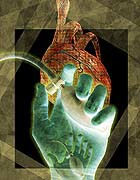
WEDNESDAY, Feb. 9 (HealthDay News) — Researchers report that a wireless implanted device monitors fluid build-up in the lungs of heart failure patients and alerts doctors when intervention is needed.
As a result, the device reduces hospitalizations and improves quality of life for these patients, they added.
“It is the build-up of fluid pressure in the lungs that causes symptoms such a shortness of breath and leads to fluid leaking into the lung, which is the major cause of hospitalization in heart failure patients,” explained study author Dr. William T. Abraham, director of the division of cardiovascular medicine at Ohio State University Medical Center in Columbus.
By monitoring the fluid pressure in the lungs, the doctor can adjust the patient’s medication to bring the pressure levels down and keep the patient out of the hospital, he noted.
“This promises to revolutionize the way we manage patients who have moderate or severe heart failure,” Abraham said. “Prior to this, the tools that we could use to evaluate how heart failure patients were doing were not very revealing and so we have failed to keep patients out of the hospital.”
The report is published in the Feb. 9 online edition of The Lancet.
For the study, Abraham’s group randomly assigned 550 patients with moderately severe heart failure to have the device implanted or not, in addition to standard medical care.
The device is placed in the pulmonary artery in the lung using a catheter, so the procedure is minimally invasive, Abraham added.
During the first six months, 83 patients with devices were hospitalized for heart failure-related problems, compared with 120 patients who did not have the device, the researchers found. That’s a 30 percent reduction in hospitalizations, they noted.
Over the entire 15 months of follow-up, those with the device had a 39 percent reduction in hospitalizations, compared with those who didn’t, Abraham’s team found.
Data from the device is picked up by an antenna outside the body that sends the information to physicians and also keeps the device powered, Abraham said.
The device has not yet been approved by the U.S. Food and Drug Administration, Abraham noted, but it is undergoing the approval process now.
If approved, it is expected to cost about $15,000, Abraham said. “A single hospitalization for heart failure costs somewhere in the neighborhood of $12,000 to $14,000. So, just avoiding one hospitalization can make this cost-effective,” he said.
Moreover, patients seem to like the device, Abraham noted: “One of our patients said they felt like we were always watching them and it gives them a sense of connectiveness to the physician and a sense of security.”
Commenting on the study, Dr. Gregg Fonarow, a professor of cardiology at the University of California, Los Angeles, said that “this study represents a major advance in the management of patients with heart failure.”
Heart failure results in substantial morbidity, mortality and health care expenditures, with more than 1 million hospitalizations for heart failure each year in the United States alone, he said.
“Worsening of congestion results in the majority of hospitalizations with heart failure, but traditional methods of monitoring symptoms and signs of heart failure have had limited success in preventing hospitalizations for heart failure,” Fonarow said.
“Wireless implantable monitoring allows for early detection of fluid accumulation, before a patient notices changes in symptoms or weight, allowing for preemptive management to address this fluid accumulation and to prevent hospitalization for worsening heart failure,” he said.
The trial was funded by CardioMEMS, the maker of the device.
More information
For more information on heart failure, visit the American Heart Association.

